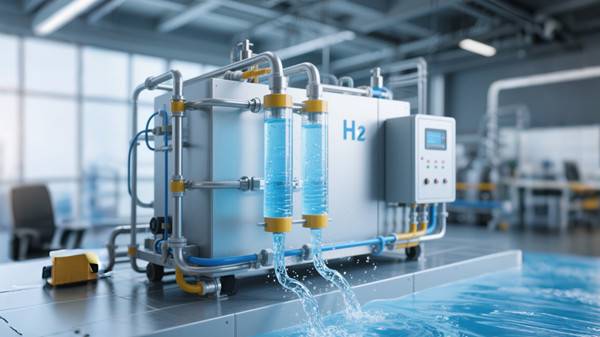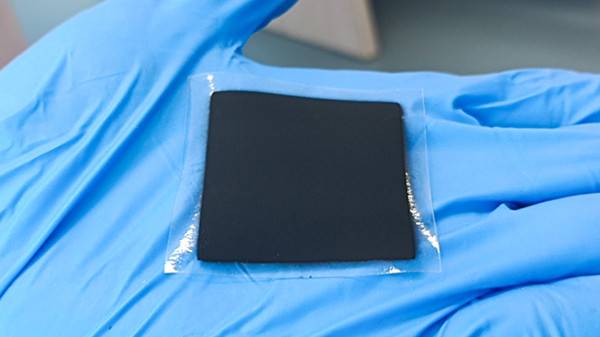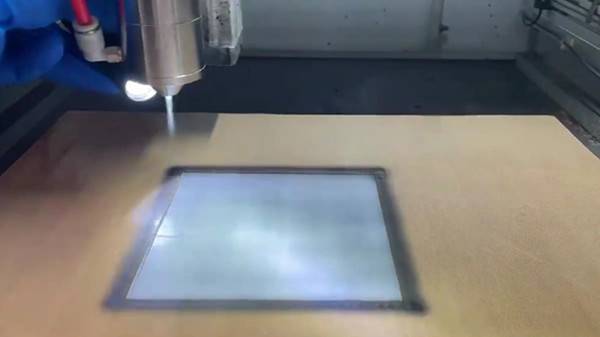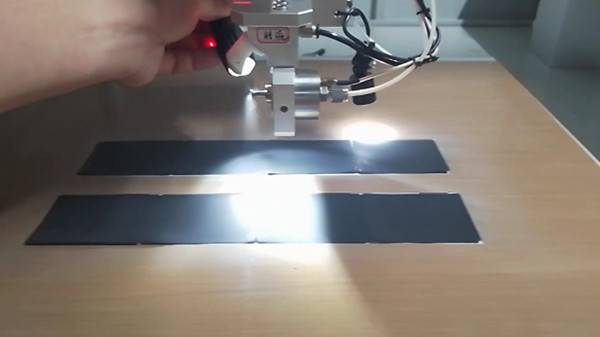The Future of Clean Energy from Water Electrolysis
In today’s global energy transformation, water electrolysis is gradually emerging as a promising clean and sustainable way to produce hydrogen, releasing its unique charm in the energy field. It is like a shining new star, bringing new hope to solving energy crises and environmental problems.
Environmental protection pioneer: pollution-free, zero-emission hydrogen production mode
From the perspective of environmental protection, the production of water electrolysis is a green model. The principle is to cleverly decompose water into hydrogen and oxygen with the help of electricity. The whole process does not produce greenhouse gases such as carbon dioxide and sulfur dioxide, and no other pollutants are emitted. Compared with traditional fossil fuel hydrogen production, the latter will release massive greenhouse gases into the atmosphere during mining, processing and conversion, causing serious damage to the environment. Water electrolysis cuts off this pollution path from the root, injects strong power into protecting the ecological balance of the earth, and becomes one of the key technologies to meet the challenge of global warming. For example, in some cities with extremely high requirements for air quality, water electrolysis is used to produce hydrogen to provide energy for fuel cell buses, which effectively reduces exhaust emissions and significantly improves urban air quality.
A perfect partner for renewable energy
With the rapid development of renewable energy such as solar energy and wind energy around the world, the intermittent and unpredictable problems of their power generation have become increasingly prominent. Solar power generation is affected by the weather and the alternation of day and night, while wind power generation depends on the strength and stability of wind power. At this time, water electrolysis hydrogen production technology is like a “golden key” that accurately opens the door to solving this problem. When there is an excess of renewable energy generation, the excess electricity can be efficiently invested in water electrolysis hydrogen production, and the electrical energy can be cleverly converted into chemical energy for storage. This not only avoids the waste of renewable energy electricity, but also greatly enhances the flexibility and efficiency of the power system. When electricity demand peaks or renewable energy generation is insufficient, the stored hydrogen can be reconverted into electrical energy through technologies such as fuel cells and stably fed back to the power grid. It is like installing an intelligent “energy buffer” for the power system, allowing renewable energy to better integrate into the existing energy system, effectively ensuring the stability and reliability of energy supply. In some areas with abundant wind resources but limited grid absorption capacity, wind power-water electrolysis hydrogen production projects are built to convert excess wind power into hydrogen storage, effectively alleviating the problem of wind abandonment and improving the comprehensive utilization efficiency of energy.
Core equipment: the diverse style of electrolyzers
Alkaline electrolyzers: the road to innovation of traditional technologies
Alkaline electrolyzers are relatively traditional and mature water electrolysis hydrogen production devices. Its electrodes are mostly made of nickel-based materials, and the electrolyte is usually potassium hydroxide (KOH) or sodium hydroxide (NaOH) solution. This type of electrolyzer has the advantages of relatively low cost and simple operation, and is still used in some small industrial hydrogen production scenarios or occasions where the purity of hydrogen is not demanding. However, it also has the shortcomings of insufficient energy efficiency, and the use of asbestos as diaphragm materials has certain environmental and safety risks. It is currently in the stage of continuous improvement. Its working principle is: in alkaline electrolyte, OH⁻ ions migrate to the anode, lose electrons on the anode surface to generate oxygen and water; at the cathode, water molecules gain electrons and combine with K⁺ (taking KOH electrolyte as an example) that migrates from the anode through the diaphragm to generate hydrogen and OH⁻, and so on, to achieve continuous water electrolysis.
Proton exchange membrane electrolyzer (PEM electrolyzer): a representative of high efficiency
PEM electrolyzer uses proton exchange membrane as a diaphragm, and the electrode generally uses precious metal catalysts (such as platinum). This electrolyzer has significant advantages such as high current density, high energy efficiency, high hydrogen purity, fast startup and response speed, etc. It is especially suitable for scenarios with large fluctuations in renewable energy power generation (such as wind power and photovoltaic power generation), and can flexibly cooperate with intermittent power sources to produce hydrogen. However, the high cost, especially the expensive price of proton exchange membranes and precious metal catalysts, limits its large-scale and low-cost promotion. It is currently mainly used in fields with high requirements for hydrogen quality, such as the production of hydrogen for fuel cell vehicles. During operation, water is oxidized on the anode surface to generate oxygen, protons (H⁺) and electrons. Protons migrate to the cathode through the proton exchange membrane in the form of hydronium ions (H₃O⁺), and are reduced to generate hydrogen by obtaining electrons on the cathode surface.
Solid oxide electrolyzer (SOEC): a potential star at high temperatures
SOEC operates at a relatively high temperature (generally around 600℃ – 1000℃), and uses ceramic materials as electrolytes. It has the advantages of high energy conversion efficiency and can be coupled with high-temperature heat sources (such as high-temperature nuclear reactors). If technical difficulties such as material stability and life at high temperatures can be overcome in the future and costs can be reduced, its application potential will be immeasurable. At present, this technology is still in the stage of research and development and small-scale demonstration applications. Under high temperature conditions, oxygen ions (O²⁻) in solid oxide electrolytes migrate from the cathode to the anode under the action of an electric field, react with the input water at the anode to generate oxygen, and at the cathode, hydrogen ions that obtain electrons from the external circuit combine with oxygen ions to generate hydrogen.
Ultrasonic spraying: innovative boost for hydrogen production from water electrolysis
In the process of the continuous development of hydrogen production technology from water electrolysis, ultrasonic spraying technology, as an innovative means, is gradually showing its unique advantages. Cheersonic ultrasonic spraying equipment can accurately and evenly spray key materials such as catalysts onto the electrode surface. Taking the proton exchange membrane electrolyzer as an example, when preparing the electrode, the dispersion and utilization rate of the catalyst can be significantly improved by evenly spraying precious metal catalysts such as platinum on the electrode through ultrasonic spraying. Traditional spraying methods may lead to uneven distribution of catalysts, accumulation of catalysts in some areas, and insufficient catalysts in some areas, which affects the electrolysis efficiency. Ultrasonic spraying can make the catalyst cover the electrode surface more evenly, reduce the reaction overpotential, and increase the catalytic activity of the electrode, thereby improving the efficiency of hydrogen production from water electrolysis. At the same time, in the alkaline electrolyzer, ultrasonic spraying can be used to treat the electrode material, which can improve the microstructure of the electrode, enhance the compatibility of the electrode and the electrolyte, promote ion migration, and increase the electrolysis reaction rate. Moreover, ultrasonic spraying technology can reduce material waste and production costs while ensuring the quality of spraying, providing strong support for the optimization and upgrading of water electrolysis hydrogen production technology.
Key factors affecting efficiency
Electrode materials: the game between performance and cost
Electrode materials play a decisive role in the catalytic activity of electrolysis reactions. Precious metal electrodes have excellent catalytic effects, can effectively reduce reaction overpotential, reduce power loss, and greatly improve hydrogen production efficiency, but the cost remains high. To this end, researchers continue to explore new electrode materials such as transition metal compounds, striving to find the best balance between cost and performance. For example, some transition metal compound electrode materials such as iron-based and cobalt-based materials show catalytic performance close to that of precious metal electrodes under specific conditions, and the cost is greatly reduced, bringing hope for large-scale application.
Electrolyte concentration and properties: subtle effects
For alkaline electrolytic cells, the appropriate electrolyte concentration is directly related to the ion migration speed and conductivity, which in turn affects the electrolysis efficiency. Different types of electrolytes, such as KOH and NaOH, have certain differences in ion migration characteristics and other aspects. Studies have shown that the precisely adjusted electrolyte concentration can increase the electrolysis efficiency by 10% – 15%. Therefore, accurate control of electrolyte concentration and selection of appropriate electrolyte types are important means to improve the efficiency of hydrogen production by water electrolysis.
Current density: Moderate is better
Properly increasing the current density can speed up the electrolysis reaction and increase the hydrogen production rate. However, too high a current density will lead to an increase in overpotential, a sharp increase in power consumption, and may also shorten the service life of materials such as electrodes. Therefore, in practical applications, it is necessary to comprehensively consider various factors and determine the optimal current density range through experiments and simulation analysis to achieve efficient and stable hydrogen production by water electrolysis.
Temperature: Regulation depending on the cell
Generally speaking, appropriately increasing the temperature can speed up the reaction rate and reduce the power required for the reaction. However, different types of electrolyzers have different sensitivity to temperature and suitable temperature ranges. Solid oxide electrolyzers need to operate at higher temperatures to fully exert their advantages, while alkaline electrolyzers and PEM electrolyzers can operate well at room temperature or a certain medium temperature range. Reasonable temperature control can significantly improve the efficiency and stability of hydrogen production by water electrolysis.
Wide range of application fields
Energy field: Promote green travel and energy storage transformation
In the energy field, hydrogen has broad application prospects as a clean energy. In terms of transportation, fuel cell vehicles use hydrogen and oxygen to react in fuel cells to generate electricity to drive vehicles, achieve zero-emission travel, and effectively alleviate urban traffic pollution. At the same time, hydrogen can be used as an excellent energy storage medium. When there is excess renewable energy generation, energy can be stored by electrolyzing water to produce hydrogen; when energy demand peaks or renewable energy generation is insufficient, the stored hydrogen can be converted into electricity to replenish the power grid, playing a key role in peak load and stabilizing energy supply. For example, hydrogen energy storage power stations built near some large wind farms can convert excess wind power into hydrogen storage, release electricity during peak power consumption, and ensure stable operation of the power grid.
Chemical field: Indispensable raw materials
In chemical production, hydrogen is an important raw material for many processes. In the production of synthetic ammonia, hydrogen and nitrogen react to produce ammonia, which is the basis of the nitrogen fertilizer industry. In the field of oil refining, hydrogen is used in processes such as hydrocracking and hydrofining, which can effectively improve the quality of oil products, increase the yield of light oil, and enhance the added value of oil products. For example, through the hydrofining process, the content of impurities such as sulfur and nitrogen in oil products can be reduced, and the pollution of automobile exhaust emissions to the environment can be reduced.
At present, the technology of hydrogen production by electrolysis of water is in a stage of rapid development and improvement. With the large-scale development and utilization of renewable energy, the projects of hydrogen production by electrolysis of water coupled with it have sprung up like mushrooms after rain. Many countries around the world have actively laid out related industries, fully promoted the development of green hydrogen production, and helped achieve the goals of energy transformation and climate change response. Although it still faces many challenges such as further cost reduction, performance improvement and life extension of key equipment such as electrolyzers, with continuous technological innovation and scale effect, hydrogen production by electrolysis of water is expected to play a more critical role in the construction of a clean energy system in the future and make great contributions to the sustainable development of human society.
About Cheersonic
Cheersonic is the leading developer and manufacturer of ultrasonic coating systems for applying precise, thin film coatings to protect, strengthen or smooth surfaces on parts and components for the microelectronics/electronics, alternative energy, medical and industrial markets, including specialized glass applications in construction and automotive.
Our coating solutions are environmentally-friendly, efficient and highly reliable, and enable dramatic reductions in overspray, savings in raw material, water and energy usage and provide improved process repeatability, transfer efficiency, high uniformity and reduced emissions.
Chinese Website: Cheersonic Provides Professional Coating Solutions






